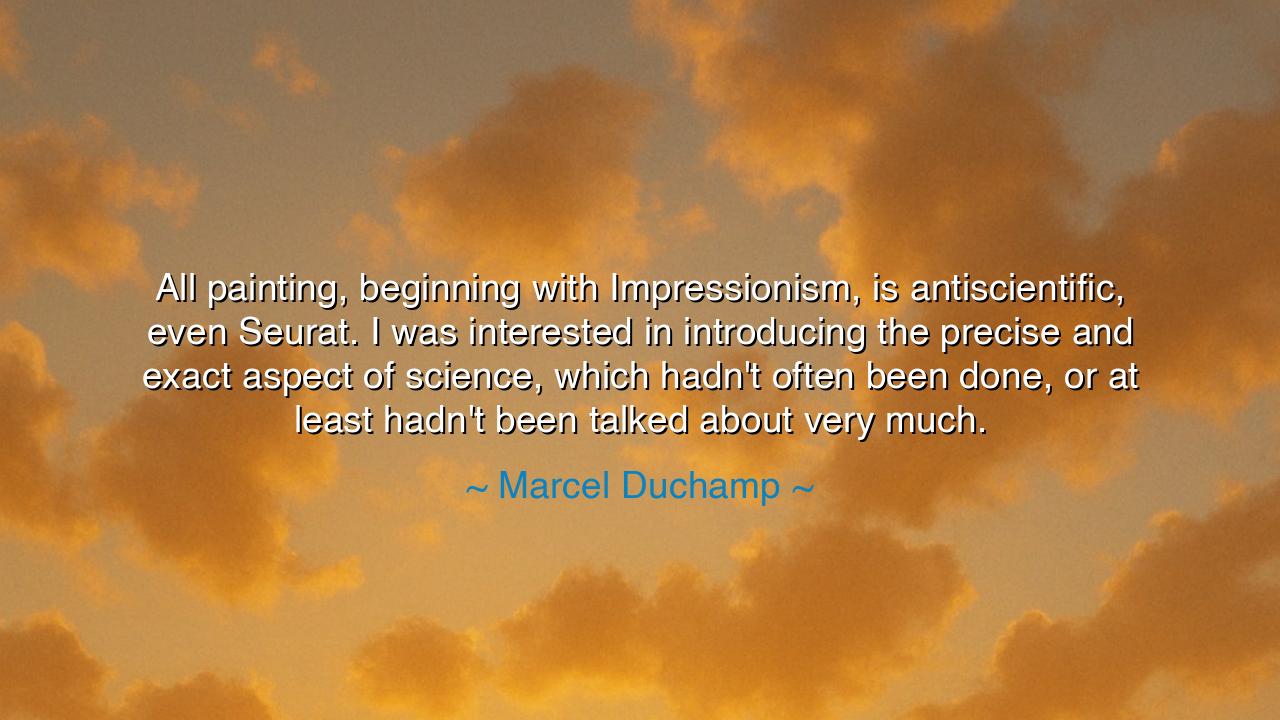
All painting, beginning with Impressionism, is antiscientific
All painting, beginning with Impressionism, is antiscientific, even Seurat. I was interested in introducing the precise and exact aspect of science, which hadn't often been done, or at least hadn't been talked about very much.






"All painting, beginning with Impressionism, is antiscientific, even Seurat. I was interested in introducing the precise and exact aspect of science, which hadn't often been done, or at least hadn't been talked about very much." These words from the visionary artist Marcel Duchamp reveal a bold confrontation between the worlds of art and science, two domains traditionally seen as distinct but, in his view, deeply intertwined. Duchamp’s statement underscores his desire to transcend the conventional methods of painting and to incorporate the exactness and precision of science into the canvas, challenging the antiscientific tendencies he saw in movements like Impressionism. While artists like Claude Monet and Georges Seurat embraced the subjective and fleeting nature of human experience, Duchamp sought to introduce something more rational, more grounded in the objective principles of science and mathematics.
In the world of the ancients, art and science were often seen as two halves of the same whole, both exploring the mysteries of nature and human existence. The Greeks celebrated both in their great philosophers and artists, understanding that reason and imagination were not opposites but complementary forces. Plato, in his dialogues, spoke of the importance of mathematics and geometry in understanding the cosmos, and the great architects and sculptors of ancient Greece understood that art had to reflect the order and harmony of the universe. In their minds, the practice of art was not just about personal expression but about uncovering the universal truths that governed the world, truths that were often hidden in the very geometry of the natural world.
Duchamp, too, was drawn to this idea, but his rebellion was against what he saw as the overly subjective nature of modern art movements such as Impressionism. For him, these movements were too far removed from the rationality and precision that defined scientific thought. Impressionism, with its emphasis on fleeting moments, light, and emotion, could be seen as an antiscientific approach, prioritizing individual perception over universal truths. Duchamp, by contrast, saw science—with its careful observations, its exact measurements, and its search for objective knowledge—as a richer source of inspiration. He sought to incorporate this rigor into his art, believing that art, like science, could uncover deeper, universal truths about the world.
Consider Leonardo da Vinci, who was both an artist and a scientist, seeking to merge the two worlds into a single vision of understanding. His studies of anatomy, engineering, and mathematics informed his artwork, and his art, in turn, was a method of exploring scientific principles. Da Vinci’s drawings of the human body, for instance, were not mere representations of physical form but detailed investigations into the mechanics of life itself. In this sense, science and art were intertwined in a way that allowed both to flourish. Duchamp, in his pursuit of blending science and art, followed in the footsteps of da Vinci, but with a more modern, even provocative twist. Duchamp’s work was not merely about precision but about challenging conventional definitions of what art could be, using science to push the boundaries of creative expression.
In his readymades, such as his famous piece, Fountain—a urinal signed with a pseudonym—Duchamp called into question the very essence of art. By introducing elements of science and mechanics into his work, he blurred the line between art and technology, using precision and industrial production as mediums of creativity. The very act of transforming a mundane object into art was a way of saying that the world of science, the world of exact measurements and logical construction, could also be part of the artist’s toolbox. Duchamp’s work was revolutionary, for it was not just about incorporating scientific elements, but about recognizing that the logic and method of science could lead to new forms of artistic expression—ones that questioned the very nature of creativity itself.
Yet, Duchamp's words also remind us that science can be, at times, an uncomfortable partner for art. The great artists of history, from the Renaissance to Impressionism, were often seen as rebels against the conventional wisdom of their times. In embracing science, Duchamp faced a similar tension—art, in its most raw and emotional form, has always been about human experience, feeling, and expression. But by introducing scientific principles into art, Duchamp sought to expand the vocabulary of art, showing that creativity could thrive even within the rigid structures of logic and reason. He thus bridged two worlds that are often kept separate—art and science—and in doing so, he transformed both.
The lesson we can draw from Duchamp’s perspective is not that we must choose between art and science, but that we must embrace both as complementary forces. Art and science are not opposing realms, but are two methods of exploring the universe. Duchamp’s work urges us to push the boundaries of both and to recognize that true innovation lies in the fusion of reason and imagination. Whether we are artists, scientists, or creators of any kind, we must ask ourselves: What can we learn by drawing from both worlds? In embracing both precision and expression, we might find new ways to understand and shape the world around us, much as Duchamp did, transforming the very definition of what it means to create.






AAdministratorAdministrator
Welcome, honored guests. Please leave a comment, we will respond soon